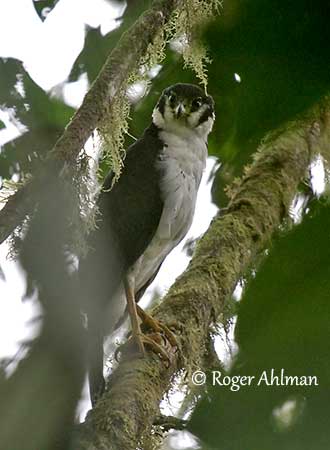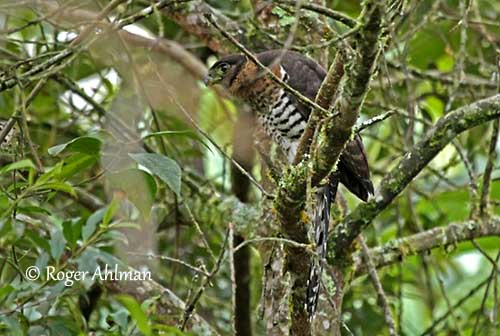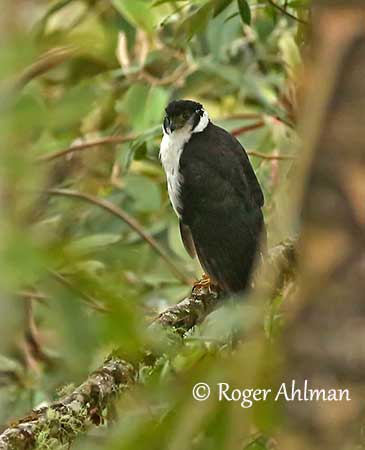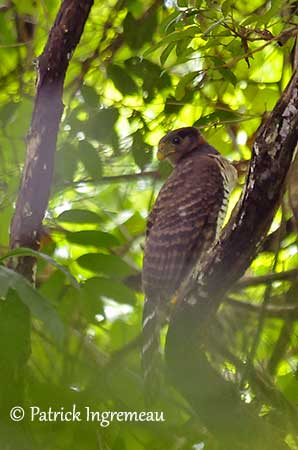
Fr: Carnifex à collier
Ang: Collared Forest-Falcon
All: Kappenwaldfalke
Esp: Halcón montés collarejo
Ita: Falco di foresta dal collare
Nd: Grote Bosvalk
Sd: halsbandsskogsfalk
Photographers:
Roger Ahlman
Pbase Galleries Peru and Ecuador & My bird pictures on IBC
Patrick Ingremeau
TAMANDUA
Text by Nicole Bouglouan
Sources :
HANDBOOK OF THE BIRDS OF THE WORLD Vol 2 by Josep del Hoyo-Andrew Elliot-Jordi Sargatal - Lynx Edicions - ISBN: 8487334156
A GUIDE TO THE BIRDS OF MEXICO AND NORTHERN CENTRAL AMERICA by Steve N. G. Howell, Sophie Webb - Oxford University Press - ISBN: 0198540124
A GUIDE TO THE BIRDS OF COLOMBIA by Steven L. Hilty and William L. Brown - Princeton University Press – ISBN 069108372X
BIRDS OF VENEZUELA by Steven L. Hilty – Ed. Christopher Helm – ISBN: 0713664185
BIRDS OF PERU by Thomas S. Schulenberg, Douglas F. Stotz, Daniel F. Lane, John P. O’Neill, Theodore A. Parker III – Princeton University Press 2007- ISBN: 978-0-691-13023-1
Collared Forest-falcon Micrastur semitorquatus courtship and mating, with take-over of a macaw nest
Breeding Ecology of Two Species of Forest-Falcons (Micrastur) in Northeastern Guatemala
Sympatric Forest-Falcons of the Genus Micrastur
Ants and foraging behavior of the Collared Forest-Falcon
Global Raptor Information Network - Working to Conserve Birds of Prey in nature
South Dakota Birds and Birding – (Terry L. Sohl)
Collared Forest-Falcon
Micrastur semitorquatus
Falconiformes Order – Falconidae Family
INTRODUCTION:
The Collared Forest-Falcon of genus Micrastur is part of the subfamily Polyborinae that gathers caracaras and forest-falcons within the order Falconiformes. Forest-falcons are secretive raptors of tropical forest. They frequent both forest interior and canopy. They are often hard to see and to study.
The Collared Forest-Falcon is the largest member of the genus Micrastur. It can be seen from Central Mexico to S Brazil. This species has three colour morphs: pale, dark and tawny. The pale nuchal collar giving the bird its name is visible across the hindneck and contrasts with the black upperparts. However, the dark form lacks this collar.
The Collared Forest-Falcon has large range, and despite its secretive habits, it is not uncommon in most part of this range. The main threat is the deforestation that destroys suitable nest-sites.
The species was recently discovered in 1978. Currently, it is not globally threatened.

DESCRIPTION OF THE BIRD:
Biometrics:
Length: 46-58 cm
Wingspan: 72-86 cm
Weight: M: 480-645 g – F: 660-940 g
The Collared Forest-Falcon in pale morph (displayed) has blackish brown upperparts. The long tail is blackish with three narrow white bars and white tip. The uppertail-coverts are also tipped white.
The underparts are white including face, cheeks and narrow collar on hindneck. The black of the crown extends diagonally forwards across the cheeks, forming a narrow, black crescent. On the underwing, the dark grey flight-feathers are barred white.
The tawny morph is similar but the underparts are cinnamon to buff, not white. The hind collar may be sometimes tawny, but it is usually white.
The dark morph is rare. It has sooty-black plumage overall, and the nuchal collar is absent. On the tail, the bars are mostly greyish-white. There is some weak barring on rump, flanks and belly.
All morphs have dull green facial skin. The bill is dark grey to blackish. The eyes are brown. Legs and feet are yellow to greenish-yellow.
The female is larger than male.
The immature resembles adult but it is brownish above, with buff-edged feathers. The nuchal collar is whitish to tawny, but it is sometimes indistinct or absent.
The underparts are white to tawny and heavily barred brown or black. The breast is washed cinnamon or chestnut. The blackish tail is barred buffy-brown or white.
Immatures gradually lose the buff scaling on the upperparts.
The dark morph immature is entirely dark brown with white barring on thighs and belly. The tail is like in adults.

SUBSPECIES AND RANGE:
The Collared Forest-Falcon has two subspecies.
M.s. naso is found in NW and NE Mexico, S through Central America to N and W Colombia, W Ecuador and extreme NW Peru (Tumbes).
This race is very similar to nominate, but it is slightly larger and darker in all plumages.
M.s. semitorquatus (described above and displayed) occurs in E Colombia, E to the Guianas, and S through E Ecuador, E Peru, N and E Bolivia, and Brazil to Paraguay and N Argentina.
HABITAT:
The Collared Forest-Falcon is usually seen at forest edge of lowland, moist to humid forest. It also frequents second growth woodland with well-developed understorey. It may occur in mangroves too. It is visible up to 2500 metres of elevation.
It often perches quietly at lower or mid-level of vegetation.
CALLS AND SONGS: SOUNDS BY XENO-CANTO
The Collared Forest-Falcon is mainly heard at dusk and before dawn, calling from high perch at forest edge. It gives a loud, hollow “cohw…cohw…cohw…” slowly repeated and far-carrying. These calls are given by both adults and often in duet, especially during the period of displays.
It also produces slightly laughing series “ka how ow ow ow” and an ascending laugh with lower, drawn-out note at the end “hoh-hoh-hoh-hoh-hoh…howh”.
The juvenile utters plaintive “mehow” or “kyeoh”.
BEHAVIOUR IN THE WILD:
The Collared Forest-Falcon feeds on a variety of vertebrates, mostly birds, including large species such as chachalacas, toucans, caciques, curassows, Ocellated Turkey, guans, owls and others. Other prey include squirrels, rats, bats, lizards and snakes. The prey is caught with the talons.
It flies from perch to perch. It hunts by stealth, followed by strong pursuit through the dense cover. It is reported running prey down on the ground too, with great speed and agility. It often runs along large branches. It usually hunts by ambush from concealed perch. It takes advantage of prey disturbed by swarms of ants.

The Collared Forest-Falcon occurs often in pairs according to the season. During the breeding season, both mates display in trees or in flight.
From an observation, both adults were displaying in a dead, decaying tree, about 15 metres from the nest-site. The male was perched at top of the snag, leaping and beating its wings, while the female was perched in bushes some metres away. This display was repeated 2-3 times at intervals of 50-60 seconds, and at various times of the day, but never during rain.
The copulation occurred several days before the nest take-over, at top of the display snag. The female left immediately after mating. Two days later, copulation occurred again. Courtship feeding is common.
This species nests in natural cavities, usually in trees. It may occupy the nest of other bird species such as Great Green Macaws, and remove eggs or/and chicks from the cavity.
The Collared Forest-Falcon is mainly sedentary in its range.
It does not soar but flies mostly through the forest or above the canopy with short, buoying flight through the trees. The long tail gives the bird great manoeuvrability. It usually avoids crossing open areas.
REPRODUCTION OF THIS SPECIES:
The breeding season occurs at the end of the rainy season. It extends through the dry season until the rainy season in June/July. The Collared Forest-Falcon usually occupies the nesting-sites in February/March.
This species nests in natural cavities, often with several entrances, and about 12-24 metres above the ground. It usually nests in large mature trees.
The female lays 2-3 dark reddish-brown eggs with darker spots. She incubates alone during 46-48 days, and she is fed by the male during this period. At hatching, the chicks have white down, pale yellow legs and cere, and pale yellowish bill. They are fed by both parents, but the male hunts more than the female.
The young fledge between 46 and 56 days after hatching, usually at about 50 days of age. They are still fed by the male for one month after fledging. They remain up to 3 kilometres from the nest during three months and start to pursue some prey six weeks after fledging.
The same nest-site is often reused in several following years.

PROTECTION / THREATS / STATUS:
The Collared Forest-Falcon is widespread and even locally common depending on the range. Due to its secretive habits, it is difficult to see and is often regarded as uncommon for this reason. It is threatened by deforestation involving the loss of suitable nesting trees.
The population is estimated to number 500,000/4,999,999 individuals by Partners in Flight (2008). It is suspected to be declining due to habitat destruction.
But currently, the Collared Forest-Falcon is evaluated as Least Concern.